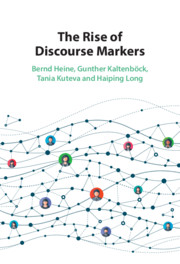Book contents
- The Rise of Discourse Markers
- The Rise of Discourse Markers
- Copyright page
- Dedication
- Contents
- Tables
- Preface
- Abbreviations
- 1 The Development of Discourse Markers
- 2 Concepts of Analysis
- 3 English Discourse Markers
- 4 French Discourse Markers
- 5 Japanese Discourse Markers
- 6 Korean Discourse Markers
- 7 Discourse Markers in Language Contact
- 8 Discussion
- 9 Conclusions
- References
- Language Index
- Author Index
- Subject Index
6 - Korean Discourse Markers
Published online by Cambridge University Press: 11 June 2021
- The Rise of Discourse Markers
- The Rise of Discourse Markers
- Copyright page
- Dedication
- Contents
- Tables
- Preface
- Abbreviations
- 1 The Development of Discourse Markers
- 2 Concepts of Analysis
- 3 English Discourse Markers
- 4 French Discourse Markers
- 5 Japanese Discourse Markers
- 6 Korean Discourse Markers
- 7 Discourse Markers in Language Contact
- 8 Discussion
- 9 Conclusions
- References
- Language Index
- Author Index
- Subject Index
Summary
In this chapter, the framework proposed in Chapter 2 is applied to the history of Korean. The discourse markers studied are icey, makilay, maliya, and tul. The findings presented are in support of the hypothesis proposed in Section 1.5, according to which discourse markers are the joint product of two separate mechanisms, with each of the mechanisms accounting for specific properties of discourse markers.
Keywords
- Type
- Chapter
- Information
- The Rise of Discourse Markers , pp. 196 - 210Publisher: Cambridge University PressPrint publication year: 2021

